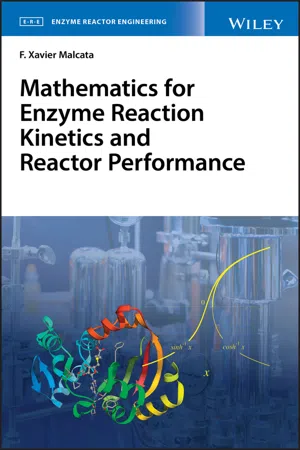Complex Hyperbolic Functions
Complex hyperbolic functions are analogs of trigonometric functions for complex numbers. They include hyperbolic sine, hyperbolic cosine, and hyperbolic tangent, among others. These functions have applications in engineering, physics, and other scientific fields, particularly in the analysis of systems with exponential behavior.
3 Key excerpts on "Complex Hyperbolic Functions"
- F. Xavier Malcata(Author)
- 2020(Publication Date)
- Wiley(Publisher)
...(2.548), since it involves only hyperbolic cosines. 2.4.3 Euler’s Form of Complex Numbers As will be derived later, the exponential of ξ may be exactly expressed as (2.551) as per Taylor’s series expanded around ξ = 0; the sine of ξ may likewise appear as (2.552) while cos ξ abides to (2.553) After setting ξ ≡ ιθ, Eq. (2.551) becomes (2.554) – where splitting of the summation between even and odd values of k was possible based on ι 2 = − 1 and ι 4 = 1 as algebraic rules (supporting switch between − 1 and 1 along consecutive terms), and ι and ι 3 = −ι (that switches between ι and −ι along consecutive terms). In view of (2.555) based on Eq. (2.552), and (2.556) stemming from Eq. (2.553), one may rewrite Eq. (2.554) as (2.557) – thus supporting Euler’s (exponential) form of a complex number a + ιb, as long as a 2 + b 2 = 1. By the same token, (2.558) based on Eq. (2.557) after replacing θ by −θ – where the even nature of cosine as per Eq. (2.296) and the odd nature of sine as per Eq. (2.295) allow further transformation to (2.559) Ordered addition of Eqs. (2.557) and (2.559) unfolds (2.560) whereas ordered subtraction thereof gives rise to (2.561) division of both sides by 2 yields (2.562) and (2.563) from Eqs. (2.560) and (2.561), respectively – or else (2.564) from Eq. (2.562) after combination with Eq. (2.473), as well as (2.565) from Eq. (2.563) following combination with Eq. (2.472). The two basic relationships between hyperbolic and circular functions are consequently conveyed by Eqs. (2.564) and (2.565). 2.4.4 Inverse Functions Inverse hyperbolic functions are often useful, and will accordingly be discussed next; in the case of sinh −1 x, one should start by setting (2.566) so application of hyperbolic sine to both sides gives rise to (2.567) – since composition of a function with its inverse cancels out their mutual effects. Insertion of Eq. (2.567) allows transformation of Eq...
- eBook - ePub
- Vencislav Cekov Valchev, Alex Van den Bossche(Authors)
- 2018(Publication Date)
- CRC Press(Publisher)
...Appendix D Mathematical Functions Here we give some properties of exponential and hyperbolic complex functions used in this. book. − 1 = (− 1) 1 / 2 = j (D.1) j = 1 + j 2 = j 1 − j 2 = j 2 1 + j (D.2) e z = e x + j y = e x (cos (y) + j sin (y)) (D.3) cosh (z) = e z + e − z 2 sinh (z) = e z − e − z 2 (D.4)[--=PL. GO-SEPARATOR=--]lim z → 0 (cosh (z)) = 1 (D.5) lim z → 0 (sinh (z)) = 0 (D.6) lim z → 0 (sinh (z) z) = 1 (D.7) tanh (z) = sinh (z) cosh (z) coth (z) = cosh (z) sinh (z) (D.8) lim z → 0 (tanh (z) z) = 1[--=PLGO-SEP. ARATOR=--]lim z → 0 (z coth (z)) = 1 (D.9) cosh 2 (z) + sinh 2 (z) = cosh (2 z) (D.10) 2 cosh (z) sinh (z) = sinh (2 z) (D.11) tanh (z) + coth (z) = 2 coth (2 z) (D.12) a z = a x + j y = e x + j y +[--=PLGO-SEPARATOR=--. ]ln (a) + j a r g (a) (D.13) (1 + j) 2 ω r coth ((1 + j) 2 ω r) = 1 2 ω r sinh (ω r) + sin (ω r) cosh (ω r) − cos (ω r) + j 1 2 ω r sinh (ω r) − sin (ω r) cosh (ω r) −[--=PLGO. -SEPARATOR=--]cos (ω r) (D.14) (1 + j) 2 ω r tanh ((1 + j) 2 ω r) = 1 2 ω r sinh (ω r) − sin (ω r) cosh (ω r) + cos (ω r) + j 1 2 ω r sinh (ω r) + sin (ω r) cosh (ω r) + cos (ω r) (D.15)[--=PLGO-S. EPARATOR=--]References [1] Foglier The Handbook of Electrical Engineering, REA staff of research and Education Association, Piscataway, NJ, 1996. [2] Jean Jacquelin, La dérivation fractionnaire: une relation générale entre la tension et le courant d’un dipôle,. Revue générale d’électricité, Recherche et développement, No. 1, Janvier 1987....
- eBook - ePub
The RF in RFID
UHF RFID in Practice
- Daniel Dobkin(Author)
- 2012(Publication Date)
- Newnes(Publisher)
...Appendix 2 Harmonic Functions A2.1 Sines and Cosines The archetype of a smooth periodic signal is the sinusoid (Figure A2.1), typically written as the product of the angular frequency ω and time t. The two closely related functions sine and cosine, abbreviated sin(x) and cos(x), where the arguments of the functions are here expressed as radians. The argument can also be expressed in degrees. There are 2 π radians in a circle, so one radian=(180/ π)≈57 degrees. Figure A2.1 Sines and Cosines as a Function of Time. Both functions are periodic with a period of 2 π radians, so if we write the sine as sin (2 π f t), where t is time, then f =1/period=frequency. We often use the angular frequency ω =2 πf, in which case the sine becomes sin(ωt). Frequency is measured in Hertz (abbreviated Hz); 1 Hz is one full cycle of the function per second. Thus when the frequency is 900 MHz=900 000 000 Hz, the angular frequency is about 5.65 billion radians per second.Both of these functions alternate between a maximum value of 1 and minimum value of −1; cosine starts at +1, and sine starts at 0, when the argument is zero. We can see that cosines and sines are identical except for an offset in the argument (the phase): (A2.1) We say that the sine lags the cosine by π/ 2 radians or 90°. A2.2 Complex Numbers and Complex Exponentials Let us now digress briefly to discuss complex numbers, for reasons that will become clear in a page or two. Imaginary numbers, the reader will recall, are introduced to provide square roots of negative reals; the unit is. A complex number is the sum of a real number and an imaginary number, often written as e.g. z = a + bi, where bi indicates the product of the real number b and the imaginary unit i. Electrical engineers often use; j instead of i, so as to use i to represent an AC current; we shall use that convention here...


